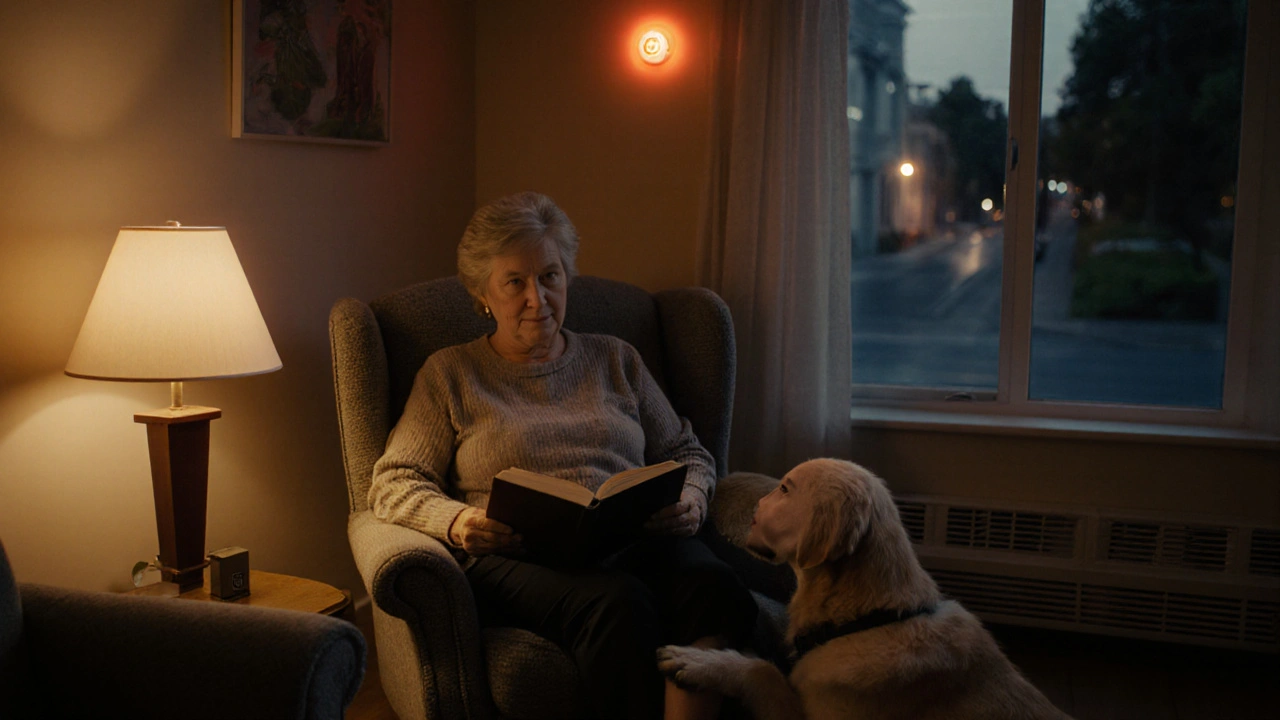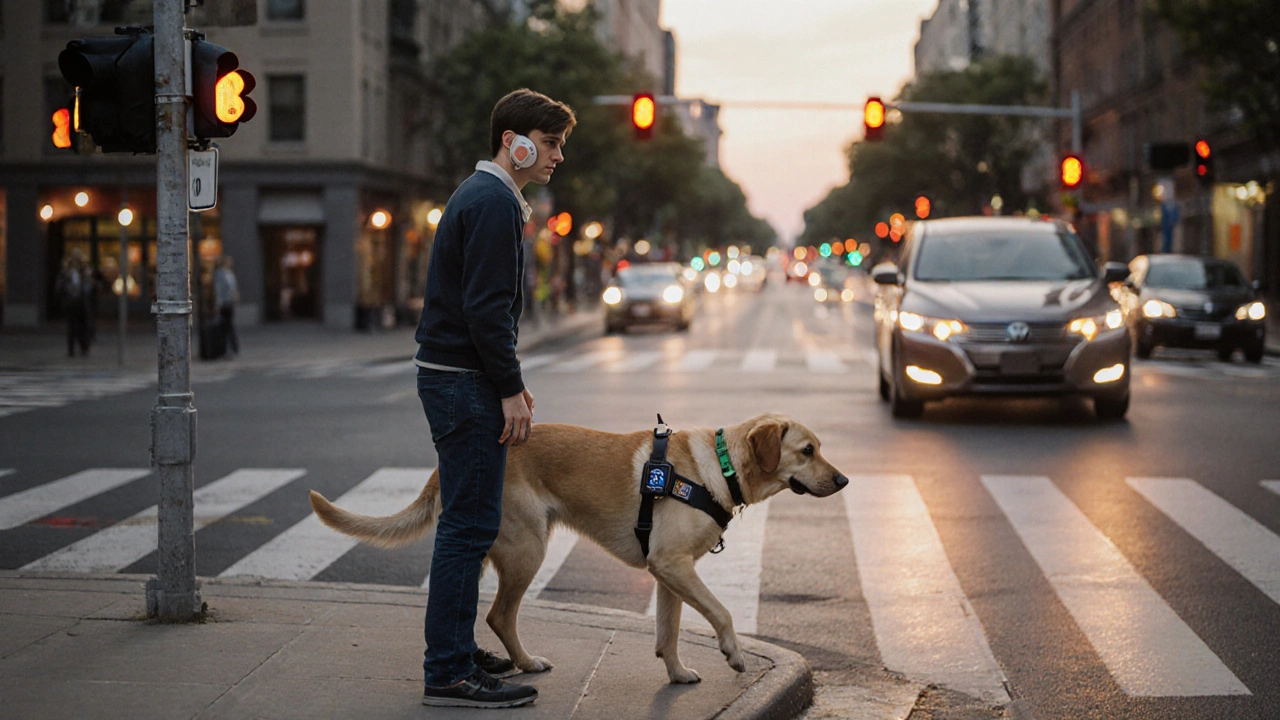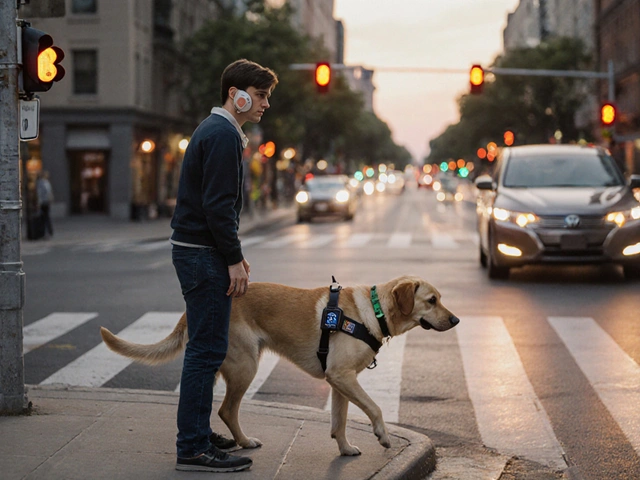Key Takeaways
- Hearing assistance dogs alert owners to sounds, boost safety and confidence.
- They complement-rather than replace-traditional hearing devices.
- Training programs cost $15,000‑$25,000 but lifelong partnership offsets the expense.
- Legal protections under the Disability Rights Act ensure public access.
- Choosing the right breed and reputable trainer matters for success.
Imagine sitting at a crosswalk, unaware that a car is about to pull out. For many living with hearing difficulty, that scenario is a daily worry. Hearing assistance dogs are specially trained canines that listen for alarms, doorbells, sirens and other crucial sounds, then alert their handler through physical cues. The result? A partner that turns invisible hazards into visible actions, letting people reclaim independence they thought they'd lost.
What Exactly Is a Hearing Assistance Dog?
A hearing assistance dog is a type of service dog trained to detect specific auditory cues and notify a person with hearing loss. Unlike pet dogs, these animals undergo a rigorous certification process, learn to differentiate between everyday noises and emergency signals, and are legally recognized as assistance animals.
How the Dog Detects and Alerts
The core of the partnership lies in two simple mechanisms: sound alert the dog's ability to recognize a pre‑defined sound pattern, such as a smoke alarm or a doorbell and vibrational cue the physical response-usually a paw tap or a nudge-to communicate the detected sound to the handler. Trainers use recordings of each target sound during the learning phase, rewarding the dog each time it correctly identifies the cue. Over months of repetition, the dog builds an internal sound library and a reliable response routine.
Safety Benefits
Studies from the University of Sydney’s School of Public Health (2023) found that participants with hearing assistance dogs experienced a 32% decrease in home‑related accidents compared to those relying on hearing aids alone. The dog can signal a fire alarm while other occupants are asleep, or warn of a approaching ambulance when traffic noise masks the siren. In outdoor settings, the animal’s alert to approaching vehicles or bicycle bells reduces the likelihood of stepping into dangerous zones.

Mental‑Health and Social Gains
Beyond physical safety, owners report reduced anxiety and higher self‑esteem. A 2022 survey of 112 dog‑owner pairs noted that 78% felt “more confident leaving the house” and 64% said the dog helped them “connect with other people,” often because the visible partnership sparks conversations. The constant companionship also combats loneliness, a common side‑effect of hearing loss.
Training and Certification
Training starts with a training program a structured curriculum that teaches dogs to recognize specific sounds and respond with a consistent alert. Programs typically last 6‑12 months and involve both the dog and the future handler. The American Kennel Club (AKC) a major breed registry that also oversees assistance‑dog standards in the U.S. and similar bodies in Australia, Canada and the UK provide third‑party certification, ensuring the dog meets national service‑animal criteria.
During the process, an occupational therapist a health professional who assesses the client’s daily‑living needs and helps integrate the dog into routines works closely with trainers. Their role includes customizing alert signals (e.g., a gentle paw tap versus a head press) to match the owner’s sensory preferences.
Choosing the Right Dog
Breed matters, but temperament is king. Labrador Retrievers, Golden Retrievers and Standard Poodles dominate the field because they combine intelligence, sociability and a calm demeanor. Smaller breeds like the Cocker Spaniel are also popular for urban dwellers where space is limited. Prospective owners should consider:
- Energy level - active owners may prefer a high‑energy Labrador.
- Allergy concerns - hypoallergenic Poodles reduce dander issues.
- Living situation - apartment‑friendly breeds need less yard space.
- Budget - initial training costs range $15,000‑$25,000, plus ongoing veterinary care.
Comparison with Other Alert Options
| Feature | Hearing Assistance Dog | Hearing Aid | Personal Alert Device |
|---|---|---|---|
| Primary Function | Detect and physically alert to sounds | Amplify environmental sounds | Vibrate or flash when specific sounds are detected |
| Mobility | Follows owner everywhere, indoor & outdoor | Requires battery, may miss sudden alarms | Usually stationary or worn on body, limited range |
| Emotional Support | Provides companionship and reduces loneliness | None | None |
| Cost (initial) | $15,000‑$25,000 (training & placement) | $2,000‑$4,000 (device) | $200‑$500 (device) |
| Legal Access | Protected under Disability Rights Act legislation granting public‑place access to assistance animals | None | None |
While the price tag looks steep, the lifelong partnership often yields savings on medical visits, home‑modification expenses and mental‑health therapy. The dog’s ability to alert to fire alarms, carbon‑monoxide detectors and even a child’s cry fills gaps that electronic devices can’t always cover.

Legal Protections and Public Access
In Australia, the Disability Rights Act federal legislation that mandates reasonable accommodation for people with disabilities, including service‑animal access guarantees that hearing assistance dogs can accompany their owners into restaurants, public transport, and government buildings. Owners should carry the dog’s identification card and a brief explanation of the animal’s role to smooth interactions with staff.
Maintaining the Partnership
Regular health checks, ongoing training refreshers, and a balanced diet keep the duo thriving. If the dog shows signs of fatigue or stress, consult a veterinarian familiar with service‑animal needs. Many organizations offer “re‑training days” where handlers can brush up on alert cues and troubleshoot new household sounds.
Next Steps for Prospective Owners
If you think a hearing assistance dog could change your life, follow this quick roadmap:
- Schedule a hearing assessment with an audiologist to confirm eligibility.
- Contact a reputable training program and request a placement questionnaire.
- Discuss budget, financing options, and potential grants (some charities cover up to 80% of costs).
- Arrange a meeting with an occupational therapist to map daily routines.
- Prepare your home-install a secure dog bed, keep essential alerts (smoke alarm, doorbell) in the dog’s auditory range.
Remember, the journey from application to placement can take 6‑12 months, but the payoff is a partner that listens, alerts, and never judges.
Frequently Asked Questions
Can a hearing assistance dog replace my hearing aids?
No. The dog is an additional layer of safety. Most owners keep their hearing aids for everyday listening and use the dog for alerting to critical sounds.
How long does training take?
Typical programs run 6‑12 months, including basic obedience, sound‑recognition drills, and public‑access etiquette.
What breeds work best?
Labrador Retrievers, Golden Retrievers, Standard Poodles and Cocker Spaniels are most common because of their temperament and trainability.
Are there any government subsidies?
In Australia, the National Disability Insurance Scheme (NDIS) can fund part of the cost for eligible participants. Check with your local provider for details.
What if the dog gets sick?
Service‑dog organizations typically include a health‑insurance clause. If the dog becomes unable to work, many groups help transition the animal to a companion role and assist the owner in finding a new partner.




Ashika Amirta varsha Balasubramanian
October 13, 2025 at 18:44When we speak of assistance dogs, we are really exploring a dialogue between species that transcends mere utility; the canine becomes a living embodiment of cultural reverence for interdependence. In many South Asian traditions, the concept of a devoted companion reflects deeper spiritual principles of duty and empathy. A hearing assistance dog not only alerts to danger, it reinforces a sense of agency that many people with hearing loss lose amid a noisy world. By integrating such a partner, individuals reclaim public spaces with confidence and assert their right to safety. This partnership, rooted in mutual respect, reshapes societal perceptions of disability.
Jacqueline von Zwehl
October 14, 2025 at 16:58The article does a commendable job outlining the training phases, yet it could further emphasize the importance of precise, inclusive language when describing the dog’s alerts. Using terms like "gentle paw tap" or "soft nudge" ensures clarity for diverse audiences. Additionally, highlighting that the dog's role complements, rather than replaces, existing hearing technologies helps avoid misunderstandings. Overall, the piece is well‑structured and accessible.
josh Furley
October 15, 2025 at 15:11Honestly, the stats are cool 😎 but don’t forget that dogs bring that extra "real‑time" vibe you can’t get from a beep. The emotional backup is like having a built‑in therapist that also spots sirens. Bottom line: they’re more than gadgets, they’re living alerts.
Jacob Smith
October 16, 2025 at 13:24Yo, this is super inspiring! Gotta say, having a dog that barks at a fire alarm is legit life‑saving. If you’re thinkin about getting one, start with basic obedience – that sets the foundation. And remember, consistent practice keeps the alerts sharp. You’ll be feelin the freedom in no time.
sara vargas martinez
October 17, 2025 at 11:38Hearing assistance dogs represent a convergence of technology, animal behavior science, and compassionate caregiving that merits thorough examination. First, the auditory discrimination capabilities of canines allow them to differentiate between a doorbell and a smoke alarm with remarkable accuracy, a skill honed through systematic exposure to recorded sound libraries. Second, the physical cues-such as a paw tap or a gentle head press-provide a tactile feedback loop that is especially valuable for individuals with both auditory and visual impairments. Third, longitudinal studies, including the 2023 University of Sydney research, demonstrate a statistically significant 32% reduction in home‑related accidents, underscoring the tangible safety benefits. Fourth, the psychosocial impact extends beyond hazard mitigation; owners report heightened self‑esteem, reduced anxiety, and increased willingness to engage in community activities. Fifth, the partnership facilitates social interaction, as the visible presence of a service dog often serves as an icebreaker and prompts inclusive dialogue. Sixth, the training regimen, typically spanning six to twelve months, integrates occupational therapists who tailor alert mechanisms to the handler’s sensory preferences, ensuring personalized efficacy. Seventh, breed selection plays a pivotal role: Labradors, Golden Retrievers, and Standard Poodles dominate due to their calm temperament, intelligence, and hypoallergenic coats, while smaller breeds such as Cocker Spaniels suit urban dwellers. Eighth, financial considerations are mitigated over time; while initial costs range from $15,000 to $25,000, the reduction in medical visits, home modifications, and mental‑health therapy often offsets the investment. Ninth, legal frameworks like the Disability Rights Act guarantee public access, yet owners must carry proper identification to navigate potential obstacles. Tenth, maintenance of the partnership requires routine health checks, diet management, and periodic re‑training sessions to address new environmental sounds. Eleventh, contingency planning for canine illness includes insurance clauses and transition programs that reassign the dog to a companion role while assisting the handler in finding a new partner. Twelfth, funding avenues such as the Australian NDIS and various charitable grants can alleviate the financial burden for eligible participants. Thirteenth, prospective owners should follow a structured roadmap-assessment, program selection, budgeting, therapy coordination, and home preparation-to ensure a smooth integration. Fourteenth, the emotional bond formed between human and dog fosters resilience against the isolation often experienced by those with hearing loss. Finally, the collaborative effort between veterinarians, trainers, therapists, and policymakers illustrates a holistic approach to disability support that can serve as a model for other assistive technologies.
Carissa Engle
October 18, 2025 at 09:51This article overstates the romance of canine assistance without addressing the real logistical nightmares you face when you adopt a service dog it sounds cute but the reality is a constant schedule of vet visits grooming and training updates the costs quoted are just the tip of the iceberg as you also have to budget for high‑quality food specialized equipment and occasional therapy for the dog itself you also need to consider the emotional toll on both parties if the dog gets sick or burns out the handler is left vulnerable again and that cycle repeats the legal protections are nice on paper but in practice many businesses still challenge the dog’s presence causing awkward confrontations that drain energy there is also the issue of public perception not everyone will see a dog as a safety tool they might view it as a stunt or a gimmick which can lead to social stigma for the handler and the dog must be trained for every possible sound scenario which is an endless task especially in noisy urban environments the article fails to mention that training quality varies widely between providers and there is no universal standard beyond basic certification a poor training program can result in missed alerts and false alarms which defeats the whole purpose the comparison table is simplistic it ignores factors like maintenance costs durability and the emotional support component that makes these dogs unique the piece could have benefited from a more critical look at the systemic challenges rather than just a glossy endorsement
Mary Cautionary
October 19, 2025 at 08:04It behooves the discerning reader to appreciate that the integration of a hearing assistance canine constitutes a paradigm shift in assistive technology, transcending mere auditory amplification. Such a synthesis of biophilic companionship and functional alertness merits scholarly commendation.
Crystal Newgen
October 20, 2025 at 06:18Sounds like a solid option.
Hannah Dawson
October 21, 2025 at 04:31While the enthusiasm expressed above is understandable, the reality of maintaining a service dog involves nuanced complexities that were glossed over; owners must navigate insurance policies that often contain hidden exclusions, and the emotional labor of constant training can be exhausting. Moreover, the purported safety benefits rely heavily on the dog's consistent performance, which can fluctuate due to age or health issues.
Julie Gray
October 22, 2025 at 02:44One must also question the broader ecosystem that enables such partnerships; the stewardship of canine service programs is often shrouded in opaque funding streams that may be linked to undisclosed interests. It is within this veil of secrecy that we should remain vigilant, ensuring that the narrative of altruistic assistance does not conceal potential agendas.